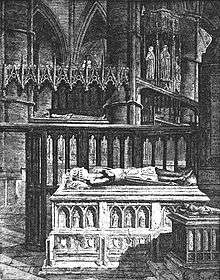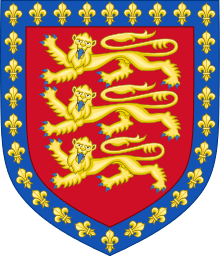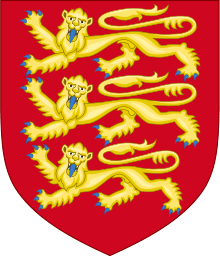John of Eltham, Earl of Cornwall
| John of Eltham | |
|---|---|
| Earl of Cornwall | |
 John on the family tree of English kings | |
| Born |
15 August 1316 Eltham Palace, Kent |
| Died |
13 September 1336 (aged 20) Perth, Scotland |
| Burial |
15 January 1337 Westminster Abbey, London |
| Father | Edward II of Carnarvon, King of England |
| Mother | Isabella of France |
John of Eltham, 1st Earl of Cornwall (15 August 1316 – 13 September 1336) was the second son of King Edward II of England and his queen Isabella of France. He was heir to the English throne from the date of the abdication of his father (25 January 1327) to the birth of his nephew Edward, the Black Prince (15 June 1330).
Life


John was born in 1316 at Eltham Palace, Kent. At the age of twelve, he was created Earl of Cornwall on 6 October 1328. Caught in the throes of the war between his father, Edward II, and mother Isabella, his growing years were turbulent. He was passed between his parents and even held in the Tower of London for a time before his brother, Edward III, led a coup against their mother and assumed his majority.
Information on John is scant, but by most historical accounts he was highly competent, and highly trusted by Edward. He was named "Guardian of the Realm" when Edward III was out of the country; was asked to open Parliament in Edward's absence, and was named Warden of the northern Marches, which gave him virtual autonomy in that portion of England.
Being the younger brother of the English monarch, since early childhood marital negotiations were made for John during his lifetime: in March 1328 Edward III entered in negotiations for a marriage between his brother and María Díaz de Haro, heiress of the Lordship of Biscay,[lower-alpha 1] and in December 1335 were made negotiations for a wedding with Joan, Countess of Penthièvre and heiress of the Duchy of Brittany;[lower-alpha 2] however, it doesn't seem that any of these arrangements resulted in an official betrothal. At the end, by contract signed on 28 September 1334, John was betrothed with Maria de La Cerda, Lady of Lunel and daughter of Ferdinand de la Cerda (grandson of King Alfonso X of Castile) by his wife Juana Núñez de Lara, Lady of Lara.[3] A dispensation was sought, but the contract was abandoned when relations between Edward and Philippe worsened in late 1334. Marie married Charles d'Évreux at Poissy in April 1335 (ref: López de Ayala, P. (1780) Crónicas de los Reyes de Castilla (Madrid), Tome II, Crónica del rey Enrique II, Año Octavo, Cap. X, p. 49.) .
At seventeen he was a key commander in the Battle of Halidon Hill (1333), a devastating defeat for the Scots. Later he commanded an army in the southwest of Scotland that put down resistance to Edward Balliol, whose claims to the Scottish throne were supported by England. According to Scottish accounts, who view John as a ruthless destroyer, he burned down Lesmahagow Abbey when it was filled with people who had sought sanctuary from the wrath of the English troops. As the Scottish chronicler John of Fordun tells it, this violation of the sacred laws of sanctuary so enraged King Edward III that he killed his own brother in fury. According to modern historian Tom Beaumont James, this tale "challenges the distinction between history and story."
John died, shortly after turning 20, at Perth, probably from a fever. Edward buried his brother with all honours in a beautiful alabaster-carved tomb in Westminster Abbey, in January 1337, and had masses said for his soul regularly.
Ancestry
| Ancestors of John of Eltham, Earl of Cornwall[4][5] | ||||||||||||||||||||||||||||||||||||||||||||||||||||||||||||||||||||||||||||||||||||||||||||||||||||||||||||||||||||||||||||||||||||||||||||||||||||||||||||||||||||||||||||||||||||||||||||||||||||||||||||||||||||||||||||||||||||||||||||||||||||||||||||||||||||||||||||||||||||||||||||||||||||||||||||||||||||||||||||||||||||||||||||||||||||||||||||||||||||||||||||||||||||||||||||||||||||||||||||||||||||||||||||||||||||||||||||||||||||||||||||||||||||||||||||||||||||||||||||||||||||||||||||||||||||||||||||||||||||||||||||||||||||||||||||||||||||||||||||||||||||||||||||||||||||||||||||||||
|---|---|---|---|---|---|---|---|---|---|---|---|---|---|---|---|---|---|---|---|---|---|---|---|---|---|---|---|---|---|---|---|---|---|---|---|---|---|---|---|---|---|---|---|---|---|---|---|---|---|---|---|---|---|---|---|---|---|---|---|---|---|---|---|---|---|---|---|---|---|---|---|---|---|---|---|---|---|---|---|---|---|---|---|---|---|---|---|---|---|---|---|---|---|---|---|---|---|---|---|---|---|---|---|---|---|---|---|---|---|---|---|---|---|---|---|---|---|---|---|---|---|---|---|---|---|---|---|---|---|---|---|---|---|---|---|---|---|---|---|---|---|---|---|---|---|---|---|---|---|---|---|---|---|---|---|---|---|---|---|---|---|---|---|---|---|---|---|---|---|---|---|---|---|---|---|---|---|---|---|---|---|---|---|---|---|---|---|---|---|---|---|---|---|---|---|---|---|---|---|---|---|---|---|---|---|---|---|---|---|---|---|---|---|---|---|---|---|---|---|---|---|---|---|---|---|---|---|---|---|---|---|---|---|---|---|---|---|---|---|---|---|---|---|---|---|---|---|---|---|---|---|---|---|---|---|---|---|---|---|---|---|---|---|---|---|---|---|---|---|---|---|---|---|---|---|---|---|---|---|---|---|---|---|---|---|---|---|---|---|---|---|---|---|---|---|---|---|---|---|---|---|---|---|---|---|---|---|---|---|---|---|---|---|---|---|---|---|---|---|---|---|---|---|---|---|---|---|---|---|---|---|---|---|---|---|---|---|---|---|---|---|---|---|---|---|---|---|---|---|---|---|---|---|---|---|---|---|---|---|---|---|---|---|---|---|---|---|---|---|---|---|---|---|---|---|---|---|---|---|---|---|---|---|---|---|---|---|---|---|---|---|---|---|---|---|---|---|---|---|---|---|---|---|---|---|---|---|---|---|---|---|---|---|---|---|---|---|---|---|---|---|---|---|---|---|---|---|---|---|---|---|---|---|---|---|---|---|---|---|---|---|---|---|---|---|---|---|---|---|---|---|---|---|---|---|---|---|---|---|---|---|---|---|---|---|---|---|---|---|---|---|---|---|---|---|---|---|---|---|---|---|---|---|---|---|---|---|---|---|---|---|---|---|---|---|---|---|---|---|---|---|---|---|---|---|---|---|---|---|---|---|---|---|---|---|---|---|---|---|---|---|---|---|---|---|---|---|---|---|---|---|---|---|---|---|---|---|---|---|---|---|---|---|---|---|---|---|---|---|---|---|---|---|---|---|---|---|---|---|---|---|---|---|---|---|---|---|---|---|---|---|---|---|---|---|---|---|---|---|---|---|---|---|---|---|---|---|---|---|---|---|---|
| ||||||||||||||||||||||||||||||||||||||||||||||||||||||||||||||||||||||||||||||||||||||||||||||||||||||||||||||||||||||||||||||||||||||||||||||||||||||||||||||||||||||||||||||||||||||||||||||||||||||||||||||||||||||||||||||||||||||||||||||||||||||||||||||||||||||||||||||||||||||||||||||||||||||||||||||||||||||||||||||||||||||||||||||||||||||||||||||||||||||||||||||||||||||||||||||||||||||||||||||||||||||||||||||||||||||||||||||||||||||||||||||||||||||||||||||||||||||||||||||||||||||||||||||||||||||||||||||||||||||||||||||||||||||||||||||||||||||||||||||||||||||||||||||||||||||||||||||||
Titles, styles, honours and arms

Arms
As Earl of Cornwall, John had use of the coat of arms of the kingdom, differenced by a bordure France (i.e. azure semy of fleur-de-lys or).[6]
Honours
Next to Eltham Palace, his birthplace, is a footpath called 'King Johns Walk', named after him.
Notes
- ↑ King Edward III wrote to “Alfonso...Castellæ...regi” and to “Marie dame de Biscay” regarding the proposed marriage between “fratrem nostrum germanum Johannem de Eltham” and “filiam dompni Johannis quondam domini de Biskae” dated 28 March 1328.[1]
- ↑ Edward III appointed “Willielmi d´Aubeneye militis et Joannis Caupegorge” as proxies to negotiate the marriage between “Joannem comitem Cornubiæ fratrem nostrum” and “Johannam filiam Guidonis de Britannia neptem et hæredem [Johanne Duce Britanniæ consanguineo nostro]” by charter dated 31 December 1335.[2]
References
- ↑ Thomas Rymer: Foedera (1740), vol. II, Pars III, p. 9. ed. A. Clarke and F. Holbrooke, London 1816.
- ↑ Pierre-Hyacinthe Morice de Beaubois: Mémoires pour servir de preuves à l´histoire ecclesiastique et civile de Bretagne, Paris 1742, vol. I, col. 1375.
- ↑ Thomas Rymer: Foedera (1740), vol. II, Pars III, p. 118. ed. A. Clarke and F. Holbrooke, London 1816.
- ↑ Maclagan, Michael; Louda, Jiří (1999), Line of Succession: Heraldry of the Royal Families of Europe, London: Little, Brown & Co, p. 17, ISBN 1-85605-469-1
- ↑ Weir, Alison (1995), Britain's Royal Families: The Complete Genealogy Revised edition, Random House, p. 92, ISBN 0-7126-7448-9
- ↑ Marks of Cadency in the British Royal Family
External links
- Scott L. Waugh (2004). "John , earl of Cornwall (1316–1336)". Oxford DNB. Retrieved 2008-02-01.
- Lineage at British Royalty/Kings of England
John of Eltham, Earl of Cornwall Born: 25 August 1316 Died: 13 September 1336 | ||
| English royalty | ||
|---|---|---|
| Preceded by Edward of Windsor, Earl of Chester |
Heir to the English Throne as heir presumptive 25 January 1327 – 15 June 1330 |
Succeeded by Edward of Woodstock, Prince of Wales as heir apparent |
| Vacant Title last held by Piers Gaveston |
Earl of Cornwall 6 October 1328 – 13 September 1336 |
Vacant Extinct; Elevation to Duchy & Dukedom Title next held by Edward, the Black Prince |
